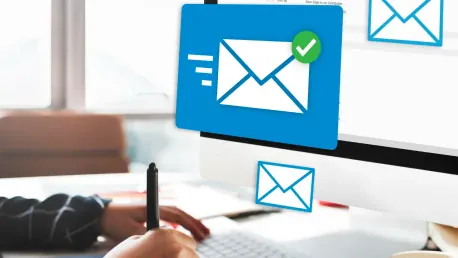In B2B retail, crafting emails that not only reach the inbox but also drive results is more critical than ever. With the potential for email-generated revenue projected to hit $17.9 billion by 2027, up from $10.3 billion in 2020, email marketing remains a high-impact tool—when done right.
On the bright side, low bounce rates are also seen in retail sectors (brick-and-mortar and online stores), indicating that engagement strategies are working well. Not only that, but email marketing is reaping the most rewards in industries such as marketing, PR, and advertising; retail; e-commerce; and consumer goods.
But making a big impact requires more than traditional tactics; it takes a strategic approach to engage today’s decision-makers and turn leads into loyal customers.
This quick read will show you how to create emails that don’t just get opened, but convert, with modern methods that deliver value and resonate with your audience.
Segmentation and Personalization
It’s important to note that personalization is not just “a first name mentioned in the email.”
It hinges on targeting a consumer with relevant and helpful content. For instance, a software development company may have one campaign targeting small business users and another targeting corporate organizations, with features that meet each segment’s needs.
In B2B, you are interacting with several users with different functions and needs. Naturally, personalization is critical. Evolving this function enables you to:
Reduce the time taken to complete the sales process
Ensure an excellent rapport with customers
Decrease overall cost of sale
Drive sales figures
Crafting a Clear Value Proposition
77% of B2B buyers prefer email as a communication method. With its direct approach, it’s an easy tool to follow up with, write detailed proposals, and track conversations.
And given that B2B buyers are exceptionally focused on solutions that solve their pain points; your emails need to quickly communicate how your products or services can help.
Picture a prospect going to a tech conference, where there are a hundred companies that are all going to solve their business woes. How do you make them hear you? Efficiently communicate your value proposition.
The goal is to get your prospects thinking: “This is exactly the problem you’re trying to solve!”. To craft this essential message:
Write your email in a straightforward way—one that speaks to your audience directly
Maintain a thorough understanding of your target market
Focus on memorability
Subject Lines That Demand Attention
Your subject line is your first impression. Make it count.
The current “industry consensus” highly advocates for short and interesting. However, depending on your sector, detailed and expressive could be the way to go. The goal is to provide a reason for your email to be opened. Find out what works best, whether it’s creating urgency, sparking curiosity, or offering clear value.
Continuous Testing
Knowing which subject line format yields the best result is a continuous process.
The advent of advanced data analytics facilitates precise customer targeting and enables hyper-personalization. With modern technology, you can create and deliver content that adjusts to user behavior in real time, enhancing engagement and boosting conversion rates.
Moreover, relying on data to guide your future efforts will help boost your open rates. With efficient A/B testing, you’ll be able to optimize your subject lines according to your audience’s preferences.
Consider:
Testing short subject lines vs. those that are longer
Toning up/down your voice: Formal vs. casual
Experimenting with different verbiage (Urgent, informative, or fun)
Strong Call-to-Actions
It is imperative to consider a call-to-action (CTA) as the trigger to the interaction process. Every email should guide recipients toward a clear, actionable next step. Whether it’s scheduling a demo, requesting a quote, or downloading a resource, your CTA needs to be simple and direct.
In B2B, the buying cycle can be long, so every interaction should move prospects closer to conversion. Always consider the use of simple yet powerful language that guides your B2B audience. For instance, using direct and short CTAs, like “Grab your guide now!” or “Join our webinar”, has proven to be more efficient.
However, a strong CTA is more than just a “Let’s talk.” Instead, they must reflect:
Clarity. Answer: “What now?” | Intrigue. Make it tempting—what’s next? | Relevance. Address the issues you’re solving. | Brevity. Less = more. | Connection. Incentivize the prospect to continue the conversation. |
Keep in mind that there is no “one fits all” CTA. What resonates with one audience may not do the same with another segment. That’s why it’s essential to test out different approaches and align all the CTAs to the peculiarities of your target audience.
Optimize Mobile for Modern Business Professionals
Business professionals are constantly on the go, making mobile optimization essential for your email marketing strategy. Ensure that your emails look great on any device by testing for different screen sizes and using responsive design to avoid formatting issues.
That is why making a site mobile friendly is not a nice-to-have—but a must-have.
If a consumer is viewing an email on his mobile, and then checks the same email on the desktop, the click-through rate increases to 65%. This ensures that busy decision-makers can read and engage with your content wherever they are, without frustrating formatting glitches.
Consistent Branding for Trust and Recognition
Consistent branding across your email campaigns builds trust and reinforces your company’s identity. Keep your emails visually cohesive with your website and other communication channels, and use a consistent tone that reflects your brand’s personality.
This consistency helps create a seamless experience for your clients, making your communications instantly recognizable and trustworthy.
Analytics: Measure, Optimize, Repeat
To get the most from your email campaigns, track key metrics such as open rates, click-through rates, and conversions. Use this data to optimize your strategy over time.
With the right approach to analytics, you’ll gain the insights necessary to answer critical questions, such as: Are certain subject lines performing better? And do certain segments respond more to specific types of content?
Continuously refine your approach to maximize the ROI from your email marketing efforts, and better understand how customers are behaving and what trends are likely to be expected.
Filter through the sea of information and find all the essential patterns and trends.
Conclusion
Strategy, precision, and customer orientation are the key success factors for email marketing in the B2B retail landscape.
With a high ROI—$36 return for every $1 spent—B2B marketers can leverage this tool to drive customer loyalty and increase conversion. Moreover, this channel empowers you to surpass the noise of social media or display ads, and helps you build a seamless, relevant, and stress-free experience.
That is why it is possible to achieve not only the attention of recipients but also their further action by personalizing content, creating effective value propositions, and adjusting such components as the subject line, the CTA, and the mobile-friendliness of the material.









